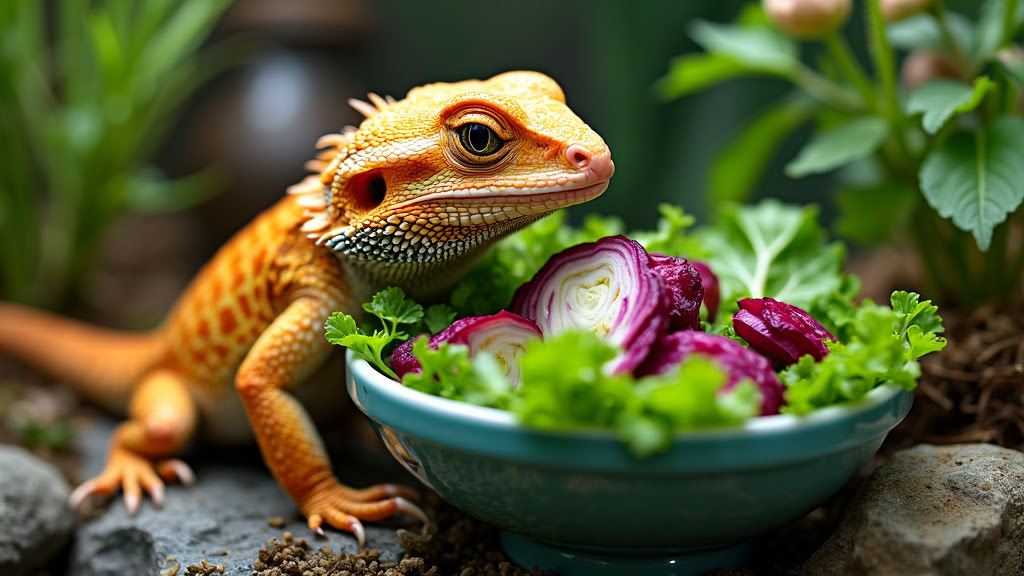As a bearded dragon owner, understanding what your pet can and cannot eat is crucial for its health and happiness. These little reptiles love to eat and might nibble on anything that seems remotely edible. It’s up to us to make sure they munch on the right stuff.
So, can bearded dragons eat radicchio? This colourful vegetable might look tempting, but is it a good choice for your scaly friend’s diet? Let’s dive into whether radicchio is a safe and beneficial addition to your bearded dragon’s meals.
Understanding Bearded Dragon Nutrition
Basic Dietary Needs
Herbivorous vs. Insectivorous Phases
Bearded dragons are not picky eaters, but their dietary needs change as they grow. When they are young, they prefer a diet rich in insects. As they grow older, they start eating more veggies. Both of these phases are important:
- Juvenile Dragons: These young dragons crave protein from insects to help them grow quickly. Crickets, mealworms, and roaches are their favourite meals.
- Adult Dragons: Adult dragons need a balanced diet of greens, vegetables, and some insects to stay healthy.
Nutritional Balance
Getting the right balance between greens, vegetables, and proteins is key to a healthy bearded dragon. Offering a variety of foods ensures they get all the essential vitamins and minerals. But it’s not just about variety; it’s also about choosing the right kinds of food. This brings us to the question: can bearded dragons eat radicchio?
Can Bearded Dragons Eat Radicchio?
Nutritional Profile of Radicchio
Here’s a quick look at what radicchio offers:
- Vitamins: Rich in vitamins A, K, and C, which support vision, bone health, and the immune system.
- Minerals: Contains calcium and phosphorus, important for bone development and metabolic processes.
- Fibre Content: Helps with digestion and promotes a healthy gut.
Health Benefits
Radicchio has several benefits:
- Antioxidants: Vitamins C and E in radicchio act as antioxidants, helping to support your bearded dragon’s immune system.
- Balanced Diet: It adds variety, preventing boredom and making meals more interesting.
- Hydration: Radicchio has high water content, which helps keep your dragon hydrated, especially if they don’t drink much water from their bowl.
Drawbacks
However, radicchio has some downsides:
- Oxalate Content: Radicchio contains oxalates, which can bind to calcium and prevent its absorption. Too much of it can lead to calcium deficiencies.
- Calcium-to-Phosphorus Ratio: The ratio in radicchio isn’t ideal, and improper calcium balance can lead to metabolic bone disease.
Personal Experience and Observations
Feeding My Own Bearded Dragons
Initial Introduction
Curiosity got the best of me, so I decided to try it out with my bearded dragons.
First, I chopped the radicchio into small pieces. No dragon should have to wrestle with their lunch! I mixed it with their regular greens and presented the colourful bowl to them.
Observations on Acceptance and Preference
Here’s what I noticed:
- Excitement: My dragons showed interest in the new addition.
- Preference: They nibbled at it without hesitation, showing they liked the purple leaves.
Monitoring Health
Of course, with new food, you have to watch their health closely. I monitored their digestion, energy levels, and overall well-being. I’m happy to report that there were no adverse reactions!
How to Safely Introduce Radicchio to Your Bearded Dragon
Preparation Tips
Introducing radicchio can be fun, but safety comes first:
- Cleaning: Wash the radicchio thoroughly to remove any pesticides or contaminants. Organic is best!
- Cutting: Chop it into small, bite-sized pieces to avoid choking hazards. Mix it with other familiar greens and veggies.
Feeding Frequency and Portion Sizes
Avoid giving too much radicchio:
- Portion Size: Small portions mixed into their regular diet should be just right. Think of radicchio as a garnish rather than the main dish.
- Frequency: Once or twice a week is a good frequency to avoid potential oxalate-related issues.
When to Consult a Veterinarian
Signs of Dietary Issues
Always watch out for potential problems:
- Digestive Issues: Look for signs like diarrhoea or constipation.
- Lethargy: If your dragon seems unusually tired or sluggish, it could mean something is wrong.
General Health Check-Ups
Regular vet visits are a must! A vet can give specific advice based on your pet’s needs, keeping them in top-notch health.
Conclusion
To wrap up:
- Benefits and Risks: Radicchio offers nutritional benefits but should be fed in moderation due to its oxalate content and calcium-to-phosphorus ratio.
- Personal Experience: My bearded dragons enjoyed it, but I kept a close eye on their health.
Remember, always introduce new foods with caution and adjust based on your pet’s reactions. Focus on providing a balanced diet tailored to your bearded dragon’s unique needs.
Now it’s your turn: Have you tried feeding radicchio to your bearded dragon? Share your experiences and questions in the comments below!
Additional Resources
- Articles on bearded dragon nutrition
- Veterinary nutrition guides
If you have any questions or need personalised advice, don’t hesitate to contact us at Dug’s Bugs!

